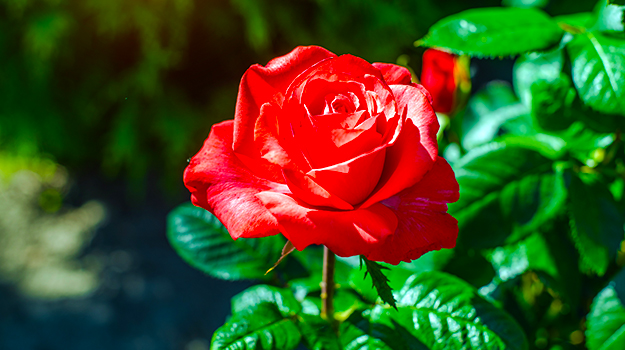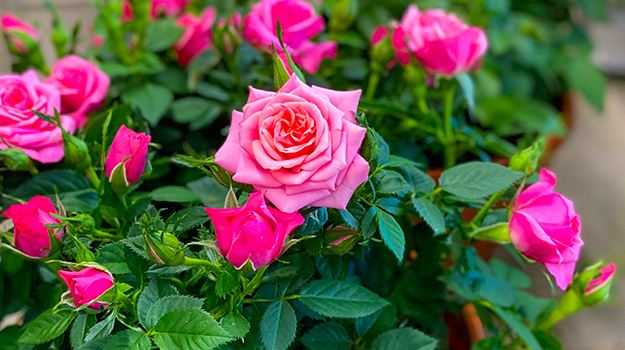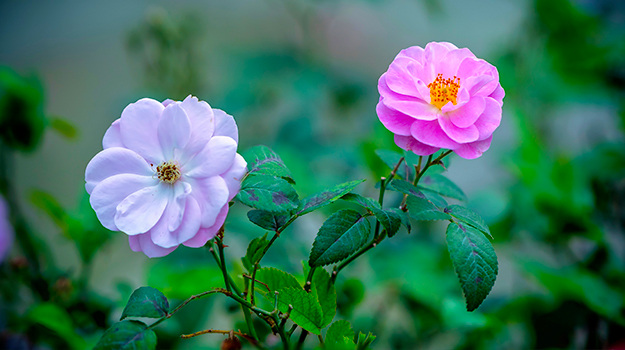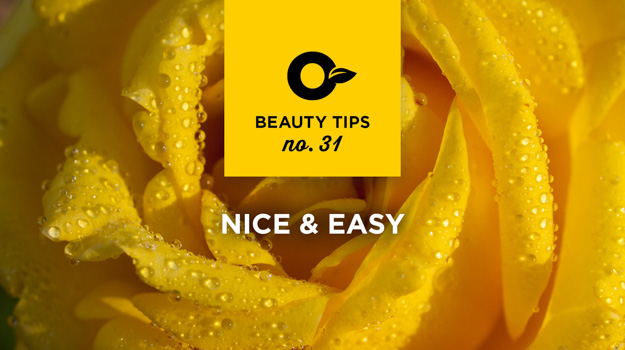
Roses remain a classic in the garden. Today, after over 100 years of selection and hybridization, there are close to 20,000 varieties that are offered in every possible hue except blue.
These past years, old and classic roses (tea hybrids, grandifloras and floribundas), which are sensitive to diseases and require winter protection, have lost ground to the benefit of modern shrub roses. Extremely vigorous, the new cultivars coming from hardy roses require very little care and will be happy to bloom from the beginning of summer until the first frosts.
The term “hardy rose” is still often associated with the wild roses covered in white or pink flowers that grow along beaches. However, hardy roses have come a long way since then. The new varieties, including those developed in Canada and England, bear flowers that are just as stunning as those of classic roses.
Climbing, trailing, bushy, semi-dwarf… From the darkest purple to the brighest yellow, today’s hardy roses know how to put on a show. To discover our selection, read 25 Easy, low-maintenance roses.
Our best tips to buy a rose.
Potted or bare-root roses?

At the start of the season, it is possible to purchase bare-root roses in stores and online. Sold or delivered in cardboard boxes or plastic bags, they must be planted very early, once the ground has completely thawed, from late April to early May (hardiness zone 5).
Otherwise, throughout the season, it is possible to buy roses in pots. Unlike perennials which sometimes don’t look that well on the shelves after June, roses do not seem to mind still being in their pot. So there is no ideal time to get them. Just make sure the rose is healthy.
Grafted roses: what you need to know

As much as possible, opt for roses grown on their own roots (cuttings) as they are much more resistant. Grafted roses are often poorly adapted to our climate and do not always survive a harsh winter. Unfortunately, the desired variety is sometimes only offered grafted.
How to tell if a rose is grafted? Unlike cuttings, it has a clearly visible callus at its base. This callus is the grafting point.
OUR TIP: You bought a grafted rose? Make sure to bury the grafting point by at least 5 cm when planting. The graft (the desired rose) can then begin to produce its own roots from the part of the stem that is underground. This will eventually allow it to free itself from its rootstock and become a non-grafted rose again.
This way, if the aboveground part freezes after a harsh winter but the roots survive, the regrowth will be that of the rose you have chosen. Otherwise, a completely different rose will appear. It’s not magic or a mutation, it is simply the rootstock coming to the surface to take the empty place!
The characteristics of a healthy rose
The size of the plant does not guarantee that the rose is healthy. Roses from cuttings are often smaller at the time of purchase than those that have been grafted. Regardless of its size, a vigorous plant will quickly expand in the garden and it won’t take long before you can enjoy its splendid flowers.
A healthy rose will have the following characteristics: the bark of its stems is green and healthy, without any suspicious spots, the buds are visible and the root system is well developed. A healthy root system allows the rose to establish properly in its new environment.
Regardless of the size of the root ball, make sure the roots are well developed. Also check that they are not spiraling; this is a sign that the rose has spent two or three years in the same pot without any repotting. Transplanting it into the ground would cause a shock that would be hard to recover from.
In the case of roses sold with bare roots, a quality plant can be recognized by the arrangement of its stems, the colour of its bark, the state of its buds and the density of its root hairs.
The plant must have at least three vigorous stems of the same circumference and 30 cm long, arranged in an open vase. The presence of sphagnum peat in the packaging ensures a good recovery of the plant, provided that it is planted at the right time. If the stems are coated with green paraffin, check that they are still alive.
The qualities sought in a rose
Beyond hardiness and resistance to diseases, look for a rose that blooms all summer long. Although there are exceptions, the majority of single-flowered wild roses are limited to one bloom per year. Those are said to be non-recurrent bloomers. Modern hardy roses offer double or semi-double flowers and their flowering is recurrent, which means they bloom continuously or several times during the season.
We particularly appreciate the cultivars from Agriculture Canada’s Explorer and Canadian Artists series, the Parkland (Morden) roses developed in the Canadian Prairies, the large family of Meidiland roses, the Flower Carpet roses, and David Austin’s spectacular English roses.
Garden centres offer a wide selection of roses and choosing is not always easy. Labels can guide you, but they can also be misleading. Read them, but remember to read between the lines as well!
Know that for hybrid tea, grandiflora and floribunda roses, the hardiness zone indicated on the label, although valid for the plant, is not necessarily valid for its flowering. Even with winter protection, there is no guarantee that your rose will survive a harsh winter or bloom every year.
Fortunately, this rule does not apply to shrub roses, whose labels can usually be relied upon. To learn more, read our article 25 Easy, low-maintenance roses.
You can't trust the hardiness zone indicated on the label, but it seems you can trust the cultivar’s name. Oso Easy and Carefree roses would therefore be good options to consider. Otherwise, ask the seller for advice or get information on the producer's site before buying.
Also take into account that the label may have been discoloured after prolonged exposure to the sun. Reading the label is the best way to make sure the pink rose you see in the picture isn't actually red!
OUR TIP: However, if you opt for a classic rose, make sure it is resistant to diseases such as black spot and mildew. Although there are products to treat them, a quick search on the Internet will save you a lot of trouble.

